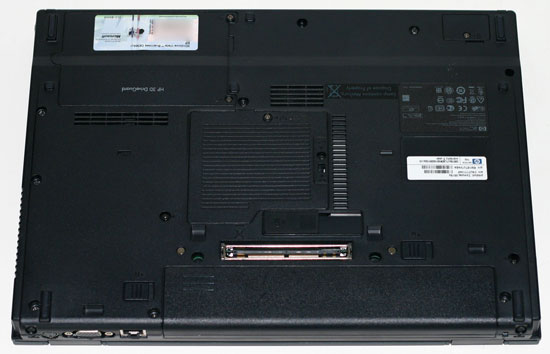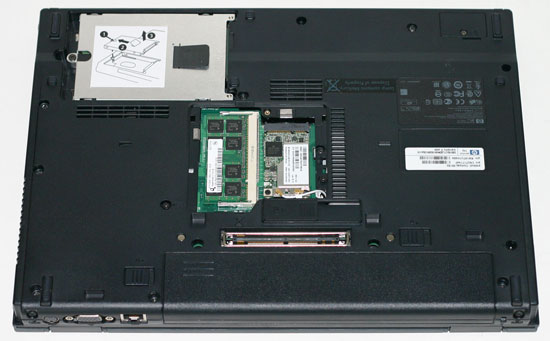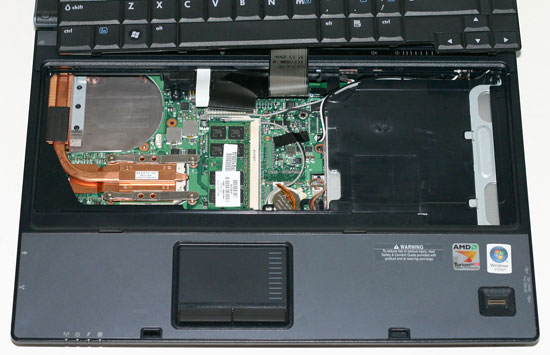Mobile Platform Wars: AMD vs. Intel
by Jarred Walton on October 5, 2007 9:10 AM EST
HP 6515b Internals
During the course of testing, we became more than just a little familiar with how to open up the 6515b and swap processors. We also performed a memory upgrade to take the system from 2x512MB of RAM up to 2x1GB. Either upgrade starts with the same step: remove the center cover on the bottom of the laptop.
Behind this panel, you can find one of the SO-DIMMs as well as the mini-PCI WiFi adapter. One of three screws that need to be loosened in order to remove the keyboard is also behind this panel.
Besides the three screws on the bottom that hold the keyboard in place, there are four plastic tabs across the top of the keyboard that need to be disengaged. After that's done, the keyboard can be lifted out of the way revealing the second memory slot as well as the CPU and its heatpipe cooler. The plastic panel above the keyboard can be popped out, which gives access to one of the two screws that holds the heatsink fan in place. After removing the fan, you can then remove the heatsink and swap out processors.
It might sound a little complex, but in reality this is one of the easier CPU swaps we've done on a laptop. Once you're familiar with the process, it's possible to swap out the CPU in under 10 minutes, and given the need to run certain benchmarks on a clean install of Windows Vista, we had to swap CPUs back-and-forth over a dozen times before we were finished with testing. We're also happy to report that during all this time, we didn't experience any system crashes or other instability that would give us cause for concern.
During the course of testing, we became more than just a little familiar with how to open up the 6515b and swap processors. We also performed a memory upgrade to take the system from 2x512MB of RAM up to 2x1GB. Either upgrade starts with the same step: remove the center cover on the bottom of the laptop.
 |
Behind this panel, you can find one of the SO-DIMMs as well as the mini-PCI WiFi adapter. One of three screws that need to be loosened in order to remove the keyboard is also behind this panel.
 |
Besides the three screws on the bottom that hold the keyboard in place, there are four plastic tabs across the top of the keyboard that need to be disengaged. After that's done, the keyboard can be lifted out of the way revealing the second memory slot as well as the CPU and its heatpipe cooler. The plastic panel above the keyboard can be popped out, which gives access to one of the two screws that holds the heatsink fan in place. After removing the fan, you can then remove the heatsink and swap out processors.
 |
It might sound a little complex, but in reality this is one of the easier CPU swaps we've done on a laptop. Once you're familiar with the process, it's possible to swap out the CPU in under 10 minutes, and given the need to run certain benchmarks on a clean install of Windows Vista, we had to swap CPUs back-and-forth over a dozen times before we were finished with testing. We're also happy to report that during all this time, we didn't experience any system crashes or other instability that would give us cause for concern.










33 Comments
View All Comments
zsdersw - Monday, October 8, 2007 - link
I'm not going to call you anything, nor am I interested in doing so. I just find it curious that the only thing you think is important just happens to be the one bright spot for AMD in the article. That's all. Read into it what you want.yyrkoon - Tuesday, October 9, 2007 - link
It would be important, because unlike all the Core2 vs AMD Fanfare, it has not been covered 5 million times already.
zsdersw - Thursday, October 11, 2007 - link
The number of times something is covered or reported has no relevance to how important it is or is not. Just because you don't want to hear the same thing "5 million times" doesn't make something else you want to hear more important.JumpingJack - Thursday, October 11, 2007 - link
You are losing this argument.JumpingJack - Sunday, October 7, 2007 - link
That tends to be the ticket, and, oh yeah, don't forget -- performance doesn't really matter, it is how it feels and the user experience.... :) It cracks me up.JarredWalton - Sunday, October 7, 2007 - link
I'm not sure what the complaint is - that I actually talked about all aspects of the platform (well, not *all*, but most), or that I wrote an article that shows that AMD's CPUs on notebooks are still slow, but their IGP tends to be better. Quite a few people have complained to Gary/Anand that we haven't looked at Intel IGP performance with X3100 (G965), so this article addresses that to a large extent. The result is a LOT better now than it was three months back, incidentally - when I first looked at an X3100 laptop, it couldn't run the vast majority of games (at least under Vista).For what it's worth, X3100 on XP may diminish AMD's "bright spot" even further. But of course, any discrete mobile GPU is still an order of magnitude faster. Results so far with X3100 XP drivers have it besting AMD's X1250 in most games. It even manages to run Bioshock (which requires SM3.0) - sure, it's only moderately playable at 800x600 minimum detail settings, but it runs. Now if Intel can just get the Vista drivers up to that level.... We're also waiting for some IGP updates, as X1250 isn't really all that new anymore.
yyrkoon - Sunday, October 7, 2007 - link
That was not a complaint Jarred, that was a suggestion, and one that was not meant as a personal attack on you. I know I am not the only one getting bored of reading the same old things time, and time again.Now, as far as the how-to suggestion, you guys are of coure going to do whatever you think you need to do. However, I find it kind of strange, that anandtech would give all kinds of details as to how you did things, without actually saying anything that leaves your readers feeling like they have learned something. I can honestly say that I haave never learned a thing here, other than when something new came out, and how it performed, etc. For instance, if I only read your site for various things, such as overclocking, I would not have the first idea of how to go about doing so myself. To me that is sort of like saying; 'look what we can do that you cannot'. Now, my main point with this example would be that not everyone out there feels comfortable reading through forum posts on various web sites for insight on how to do these certain things, and would rather look to you, the anandtech technical writters for guidance on these matters. Is that really too much for your readers, and in this case me, to ask of you ? Give us DETAILS !
There are plenty of things I like about your web articles, but as far as actually learning anything technical . . . this has not happend for me here in quite some time, if ever.
And once again please fix your comment section timeout error . . . gets really annoying.
JarredWalton - Sunday, October 7, 2007 - link
I should also point out, if you weren't aware, that most of us focus on specific areas. Right now, I'm primarily looking at laptops and displays, with an occasional buyer's guide or system review. SAS might interest some of you, but that's not even remotely interesting to me and hence it's not in my area of expertise. SATA port multipliers also don't concern me, as I rarely use more than two HDDs in a system. Personally, I think a look at how the mobile platforms from AMD and Intel compare to each other is going to be far more interesting to a larger audience than a look at something like SAN, SAS, or what have you - not that someone from AT might not cover the other areas, but I can pretty much guarantee it won't be me.Overclocking is something we've also covered in the past, and pretty much every motherboard article provides a reasonable amount of information on the subject. given that OC'ing is pretty BIOS/platform specific, it belongs there more than in a separate article. I think there will be some additional information on the topic in some upcoming reviews, but I don't know that anyone is planning on a separate "How To" article. (We haven't done many of those.)
--Jarred
yyrkoon - Sunday, October 7, 2007 - link
Also, I think it would be good, if while covering different products, that it would be good if anandtech would list the pro's and con's of each aspect of a subject. If anyone is like myself, 'we' do not bothing reading most of he article, because it is either boring, obvious, or is just otherwise not nessisary to read. This last aspect has nothing really to do with anandtechs ability to write an exiciting article(except perhaps that I personally find some to be long, and drawn out), and has more to do with the different aspects of the subjects mentioned.ltcommanderdata - Saturday, October 6, 2007 - link
Well, I guess as you point out the Vista drivers for the GMA X3100 are still immature. I'm not even sure the 15.6/15.6.1 Vista drivers even enable hardware DX9.0c support like the XP drivers does since the Vista release notes have never mentioned it being added. Anyways, I'm definitely looking forward to those XP results with the GMA X3100. I hope you will use the 14.31.1 drivers since it fixed the hardware/software acceleration toggle problem with the 14.31 drivers.